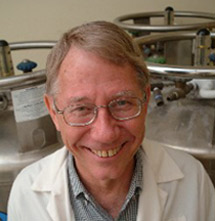C. Nick Pace, PhD

C. Nick Pace, PhD
Distinguished Professor
Regents Professor
McMullin Professor of Genetics
Contact
Molecular & Cellular Medicine
TX
Phone: tel:979.845.1788
Biography
Nick Pace received his BS in chemistry from the University of Utah in 1962, and his PhD in biochemistry from Duke University in 1966 working with Dr. Charles Tanford. His postdoctoral work was in the chemistry department at Cornell University working with Dr. Gordon Hammes. He joined the faculty at Texas A&M University in 1968. In 1982, he took a sabbatical at the MRC Centre in Cambridge, England, working with Dr. Tom Creighton and Dr. Alan Barrett. In 1992, he was a visiting professor at Osaka University in the Institute for Protein Research.Research Interests
- The important tasks in living cells are carried out by proteins in which the polypeptide chain is folded into a globular structure that is essential for their biological function. The amino acid sequence of the protein determines the folded structure. Proteins can now be constructed with any desired amino acid sequence. The potential applications of this technology in health and other areas are limited only by our knowledge and imagination. Pace's research examines how changes in the amino acid sequence affect the structure, function, solubility, and stability of a protein. His ultimate goal is to be able to predict the folded structure of a protein given just the amino acid sequence.
Representative Publications
- Grimsley, G.R., Scholtz, J.M., and Pace, C.N. (2009) A summary of the measured pK values of the ionizable groups in folded proteins. Protein Sci. 18(1): 247-251.
- Pace, C.N., Grimsley, G.R., and Scholtz, J.M. (2009) Protein ionizable groups: pK values and their contribution to protein stability and solubility. J Biol Chem. Jan 21. [Epub ahead of print]
- Trevino, S.R., Scholtz, J.M., and Pace, C.N. (2008) Measuring and increasing protein solubility. J. Pharm. Sci. 97(10): 4155-4166. Review.
- Alston, R.W., Lasagna, M., Grimsley, G.R., Scholtz, J.M., Reinhart, G.D., and Pace, C.N. (2008) Tryptophan fluorescence reveals the presence of long-range interactions in the denatured state of ribonuclease Sa. Biophys. J. 94(6): 2288-2296.
- Trevino, S.R., Schaefer, S., Scholtz, J.M., and Pace, C.N. (2007) Increasing protein conformational stability by optimizing beta-turn sequence. J. Mol. Biol. 373(1):211-218.
- Trevino, S., Scholtz, J.M., and Pace, C.N. (2007) Amino Acid Contribution to Protein Solubility: Asp, Glu, and Ser Contribute More Favorably than the other Hydrophilic Amino Acids in Ribonuclease Sa. J. Mol. Biol. 366, 449-460.